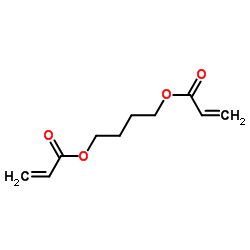

1,4-双(丙烯酰氧基)丁烷结构式

|
常用名 | 1,4-双(丙烯酰氧基)丁烷 | 英文名 | 1,4-Butanediol Diacrylate |
|---|---|---|---|---|
| CAS号 | 1070-70-8 | 分子量 | 198.216 | |
| 密度 | 1.0±0.1 g/cm3 | 沸点 | 267.6±23.0 °C at 760 mmHg | |
| 分子式 | C10H14O4 | 熔点 | -7°C | |
| MSDS | 中文版 美版 | 闪点 | 126.2±21.0 °C | |
| 符号 |


GHS05, GHS07 |
信号词 | Danger |
|
Interaction of intraocular lenses with fibronectin and human lens epithelial cells: Effect of chemical composition and aging.
J. Biomed. Mater. Res. A 103 , 3843-51, (2015) The aim of this study is to investigate in vitro interactions between hydrophobic acrylate intraocular lenses (IOLs) and their biological environment. The influence of lens chemical composition and aging on fibronectin (FN) adsorption and on IOLs cytotoxicity... |
|
|
Nanoparticles that deliver triplex-forming peptide nucleic acid molecules correct F508del CFTR in airway epithelium.
Nat. Commun. 6 , 6952, (2015) Cystic fibrosis (CF) is a lethal genetic disorder most commonly caused by the F508del mutation in the cystic fibrosis transmembrane conductance regulator (CFTR) gene. It is not readily amenable to gene therapy because of its systemic nature and challenges inc... |
|
|
Polymeric nanoparticles for nonviral gene therapy extend brain tumor survival in vivo.
ACS Nano 9(2) , 1236-49, (2015) Biodegradable polymeric nanoparticles have the potential to be safer alternatives to viruses for gene delivery; however, their use has been limited by poor efficacy in vivo. In this work, we synthesize and characterize polymeric gene delivery nanoparticles an... |
|
|
Niemann-Pick C1 affects the gene delivery efficacy of degradable polymeric nanoparticles.
ACS Nano 8(8) , 7905-13, (2014) Despite intensive research effort, the rational design of improved nanoparticulate drug carriers remains challenging, in part due to a limited understanding of the determinants of nanoparticle entry and transport in target cells. Recent studies have shown tha... |
|
|
Biodegradable DNA Nanoparticles that Provide Widespread Gene Delivery in the Brain.
Small 12 , 678-85, (2016) Successful gene therapy of neurological disorders is predicated on achieving widespread and uniform transgene expression throughout the affected disease area in the brain. However, conventional gene vectors preferentially travel through low-resistance perivas... |
|
|
CEC separation of peptides using a poly(hexyl acrylate-co-1,4-butanediol diacrylate-co-[2-(acryloyloxy)ethyl]trimethyl ammonium chloride) monolithic column.
Electrophoresis 29(18) , 3875-86, (2008) A polyacrylate-based monolithic column bearing cationic functionalities and designed for capillary electrochromatography (CEC) has been prepared via photopolymerization of a mixture of hexyl acrylate, butanediol diacrylate, 2-(acryloyloxy) ethyltrimethyl ammo... |
|
|
A new carboxylesterase from Brevibacterium linens IFO 12171 responsible for the conversion of 1,4-butanediol diacrylate to 4-hydroxybutyl acrylate: purification, characterization, gene cloning, and gene expression in Escherichia coli.
Biosci. Biotechnol. Biochem. 63(4) , 688-97, (1999) A carboxylesterase that is responsible for conversion of 1,4-butanediol diacrylate (BDA) to 4-hydroxybutyl acrylate (4HBA) was found in Brevibacterium lines IFO 12171, and purified to homogeneity. The purified enzyme was active toward a variety of diesters of... |
|
|
The effects of cross-linking agents on some properties of HEMA-based resins.
J. Dent. Res. 74(9) , 1597-601, (1995) The use of 2-hydroxyethyl methacrylate (HEMA)-based polymer as a biocompatible material has been well-established. HEMA-based resins containing cross-linking agents have several potential clinical applications. It is hypothesized that the incorporation of cro... |
|
|
The effects of cross-linking agents on the water sorption and solubility characteristics of denture base resin.
J. Oral Rehabil. 23(7) , 476-80, (1996) Six different cross-linking agents were added to the monomer component of an autopolymerizing denture base resin, and their effects on the water sorption and solubility were investigated. The results of this study suggested that the chemical nature of the pol... |
|
|
Cross-linked polyethylenimine as potential DNA vector for gene delivery with high efficiency and low cytotoxicity.
Acta Biochim. Biophys. Sin. (Shanghai) 38(11) , 780-7, (2006) Polyethylenimine (PEI) has been known as an efficient gene carrier with the highest cationic charge potential. High transfection efficiency of PEI, along with its cytotoxicity, strongly depends on its molecular weight. To enhance its gene delivery efficiency ... |